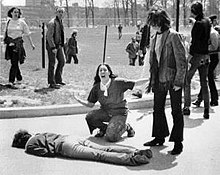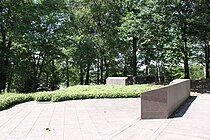Alan Canfora
| Kent State shootings | |
|---|---|

John Filo's Pulitzer Prize–winning photograph of Mary Ann Vecchio, a 14-year-old runaway, kneeling over the body of Jeffrey Miller minutes after he was fatally shot by the Ohio National Guard
|
|
| Location | Kent State University, Kent, Ohio, United States |
| Date | May 4, 1970 12:24 p.m. (Eastern: UTC−5) |
| Weapons | |
| Deaths | 4 |
|
Non-fatal injuries
|
9 |
| Victims | Kent State University students |
| Perpetrators | Ohio National Guard |
|
May 4, 1970, Kent State Shootings Site
|
|
| Location | 0.5 mi. SE of the intersection of E. Main St. and S. Lincoln St., Kent, Ohio |
| Coordinates | 41°09′00″N 81°20′36″W / 41.150092°N 81.343353°WCoordinates: 41°09′00″N 81°20′36″W / 41.150092°N 81.343353°W |
| Area | 17.24 acres (6.98 ha) |
| NRHP reference # | 10000046 |
| Significant dates | |
| Added to NRHP | February 23, 2010 |
| Designated NHL | December 23, 2016 |
 |
|
|
|
The Kent State shootings (also known as the May 4 massacre or the Kent State massacre) were the shootings of unarmed college students protesting the Vietnam War at Kent State University in Kent, Ohio, by members of the Ohio National Guard on May 4, 1970. Twenty-nine guardsmen fired approximately 67 rounds over a period of 13 seconds, killing four students and wounding nine others, one of whom suffered permanent paralysis.
Some of the students who were shot had been protesting the Cambodian Campaign, which President Richard Nixon announced during a television address on April 30. Other students who were shot had been walking nearby or observing the protest from a distance.
There was a significant national response to the shootings: hundreds of universities, colleges, and high schools closed throughout the United States due to a student strike of 4 million students, and the event further affected public opinion, at an already socially contentious time, over the role of the United States in the Vietnam War.
Richard Nixon was elected president of the United States in 1968, promising to end the Vietnam War. In November 1969, the My Lai Massacre by American troops of between 347 and 504 civilians in a Vietnamese village was exposed, leading to increased public opposition in the United States to the war. The nature of the draft also changed in December 1969, with the first draft lottery since World War II. This eliminated deferments allowed in the prior draft process, affecting many college students and teachers.
The war had appeared to be winding down in 1969, so the new invasion of Cambodia angered those who believed it only exacerbated the conflict. Across the U.S., campuses erupted in protests in what Time called "a nation-wide student strike", setting the stage for the events of early May 1970.
...
Wikipedia


